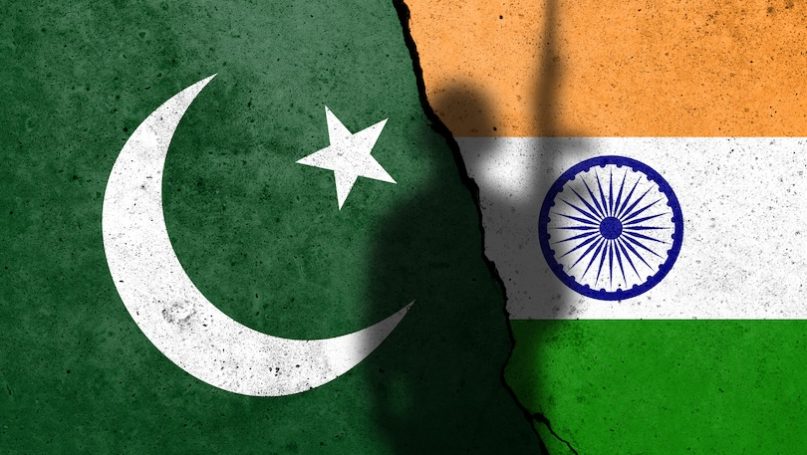
Tomas Ragina /Shutterstock
On May 6–7, 2025, the Indo-Pacific region was jolted by a sudden military escalation between India and Pakistan. Following an attack that killed 26 civilians, India launched a coordinated airstrike on targets it claimed were linked to Pakistan-based militant networks. Pakistan retaliated with air operations and claimed to have downed multiple Indian aircraft. As media reports circulated images of explosions and mourning civilians on both sides, international observers were reminded that these two nuclear-armed neighbors, long embroiled in enmity, remain one miscalculation away from catastrophe. This is not merely a story of South Asian rivalry, it is an event that reverberates through the broader Indo-Pacific, revealing structural vulnerabilities and ideological fault lines in an already fragmented regional order.
The confrontation is not an isolated bilateral episode; it must be interpreted as a crisis of hegemony, a rupture within the shifting geopolitical architecture of the Indo-Pacific, where nuclear deterrence, bloc politics, and great-power competition collide. Indeed, it’s important to move beyond surface-level explanations of retaliation and security. Instead, it reveals the structural logics of power, alignment, and systemic transformation that underpin the current volatility. What is at stake is not just the future of South Asian stability but the coherence and manageability of the Indo-Pacific as a strategic region. In conventional security studies, the India–Pakistan rivalry is often viewed through the lens of deterrence theory, a delicate balance upheld by mutual nuclear capability. Each side threatens unacceptable damage in the event of full-scale war, thus deterring escalation. However, the key concern is not merely the balance of arms but the context within which deterrence operates.
In the current Indo-Pacific order, India and Pakistan are no longer just adversaries; they are structurally embedded in competing geopolitical blocs. India’s alignment with the United States has deepened markedly since the early 2000s, culminating in robust defense agreements, increased Quad cooperation, and technological-military integration. Pakistan, once ambiguously tied to both the US and China, is now firmly within China’s strategic orbit. Its dependence on Chinese capital, weapons systems, and diplomatic support through the Belt and Road Initiative, especially the China–Pakistan Economic Corridor (CPEC), has turned Islamabad into a subordinate actor in Beijing’s broader regional design.
This means that military action between India and Pakistan is now seen not only as bilateral escalation but also as signaling inside a multipolar competition. For instance, the recent missile exchanges were interpreted in Beijing as a test of Pakistan’s vulnerability and in Washington as proof of India’s strategic will. In this way, the crisis serves as a proxy performance, militarized representation of the larger fight over regional hegemony between the U.S.-led and China-led orders.
Geopolitically, the Indo-Pacific was initially viewed as an inclusive area where a framework could reconcile economic interdependence with great power rivalry. Middle powers would maintain their autonomy in this perspective; regional institutions would help to mitigate conflict; and maritime security would support collective prosperity. However, the last five years have seen this environment become militarized and polarized. Based on the containment of China, U.S. Indo-Pacific strategy has been reinforced through Aukus, the Quad, and bilateral military basing agreements. China’s response has been to bolster its sphere of influence through infrastructure-led diplomacy, an aggressive posture in disputed areas like the Himalayas and the South China Sea, and coercive economic pressure.
Two outcomes arise from this targeted hardening. First, it has narrowed the space for diplomatic uncertainty, thereby requiring states to declare either explicit or implied alignments. Second, it has lowered the threshold of appropriate confrontation. The crisis between India and Pakistan exemplifies this trend. Ten years ago, such a military interaction between two nuclear powers may have incited a diplomatic frenzy. Today, it is accepted and portrayed as controllable, even unavoidable, given that the regional order has adapted to a new normal of instability.
The normalization of limited military interaction between nuclear countries is among the most concerning aspects of this issue. India and Pakistan appear to have adjusted their behavior below the level of full-scale war. India employed precision bombs for “surgical strikes,” whereas Pakistan’s response was tactical, controlled, and intended for both internal and external audience. Still, this normalization is quite perilous. “Limited war” is essentially contradictory in a nuclearized environment. Unpredictable escalation dynamics imply that deterrent relies as much on perception as on capacity. Moreover, the risk of misinterpretation increases when military action becomes a means of strategic signaling, not just toward one’s opponent, but also toward external actors like the United States and China.
Under these circumstances, deterrence is a display of performative rationality rather than a stabilizing factor. One type of political currency is the ability to demonstrate a willingness to employ force and appear adamant. In this sense, nuclear weapons do not just discourage; they also shape the fundamental logic of conflict, thus incorporating crises into the grammar of diplomacy. This paralysis points to a broader issue: the disintegration of normative power in global security. Once supportive of world order, the UN Security Council, the Non-Aligned Movement, and international arms control forums have lost credibility and operational capability. What remains is a fractured landscape of bilateral agreements, ad hoc alliances, and regional orders molded more by infrastructure and weaponry than by standards or diplomacy.
If the India–Pakistan dispute offers lessons, the Indo-Pacific is not moving toward stable multipolarity. Rather, it is veering into a post-hegemonic state in which the vacuum is filled not by cooperation but by conflict, and no single actor can set the direction. This presents a challenging task for both academics and legislators. How can we envision a regional security arrangement that neither relies on weak institutions nor reflects great power competition? How can we create new paradigms of strategic pluralism that can help accommodate conflict without spiraling into war? One starting point is recognizing that order must be created rather than taken for granted. It requires shared standards of engagement, ongoing diplomatic investment, and crisis management systems free from the influence of powerful states. It also necessitates acknowledging the limitations of deterrence and the risks of presuming reason in every strategic calculation.
The India–Pakistan clash of May 2025 will be remembered for what it revealed about the Indo-Pacific security order—its fragility, fragmentation, and growing militarization—not for the extent of its devastation. What we are witnessing is not the resurgence of history. Rather, the post-Cold War illusions give way to a hazardous landscape where the nuclear shadow looms large and the tools for managing it become increasingly outdated. In this context, the decision is clear-cut. Regional actors and global powers must either embrace a future shaped by episodic crises, proxy signals, and the ever-present risk of catastrophic error or commit to reshaping the Indo-Pacific as a zone of negotiated coexistence.
Further Reading on E-International Relations
About The Author(s)
Aniello Iannone is a Lecturer at the Department of Government and Political Studies, Universitas Diponegoro Semarang, Indonesia.
Before you download your free e-book, please consider donating to support open access publishing.
E-IR is an independent non-profit publisher run by an all volunteer team. Your donations allow us to invest in new open access titles and pay our bandwidth bills to ensure we keep our existing titles free to view. Any amount, in any currency, is appreciated. Many thanks!
Donations are voluntary and not required to download the e-book - your link to download is below.

 Movie
Movie 3 months ago
157
3 months ago
157 






![Presidents Day Weekend Car Sales [2021 Edition] Presidents Day Weekend Car Sales [2021 Edition]](https://www.findthebestcarprice.com/wp-content/uploads/Presidents-Day-Weekend-car-sales.jpg)



 English (United States)
English (United States)